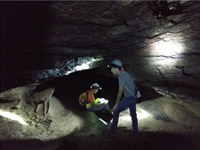ICP-MS Laboratory
The MTSU Inductively Coupled Plasma Mass Spectrometry (ICP-MS) lab was funded by a $122,000 grant from the National Science Foundation. The lab provides analytical training and research opportunities for undergraduate geoscience majors. The lab also is used to reinforce course learning objectives in MTSU undergraduate mineralogy, petrology and geochemistry courses. Undergraduates enrolled in introductory Earth science and introductory geology courses also use the lab to complete exercises addressing the scientific method and drinking water quality.
The ICP-MS lab is available for use by professors and students from all MTSU science departments, as well as non-MTSU users. Along with the Department of Geoscience X-ray fluorescence lab, the ICP-MS lab offers a wide range of analytical capabilities. Both labs are staffed by Dep. of Geoscience faculty and students. All analytical expenses must be covered by each user. For more information on user fees, please contact Dr. Warner Cribb.
What is ICPMS?
ICP-MS is an anlytical method capable of rapidly measuring the concentrations of almost all chemical elements in any geologic sample. ICPMS accomplishes this by counting the number of ions at a certain mass of the element. Standards are analyzed to generate a calibration curve and the signals from unknown samples are compared against the calibration curve to determine the concentration of each metal in the sample. ICP-MS can measure as many as 35 elements in a single sample in as little as three minutes. Detection limits for almost all isotopes are at the parts-per-billion level.
The ICP-MS consists of the following parts:
- Sample introduction system – consists of the peristaltic pump, nebulizer, and spray chamber and provides the means of getting samples into the instrument
- ICP torch – generates the plasma which serves as the ion source of the ICP-MS, converting the analyte atoms to ions
- Interface – links the atmospheric pressure ICP ion source and the high vacuum mass spectrometer
- Vacuum system – provides high vacuum for ion optics, quadrupole, and detector
- Lens – focuses ions into a beam for transmission into the quadrupole
- Quadrupole – acts as a mass filter to sort ions by their mass to- charge ratio (m/z)
- Detector – counts individual ions passing through the quadrupole data handling and system
- Controller – controls all aspects of instrument control and data handling to obtain final concentration
results
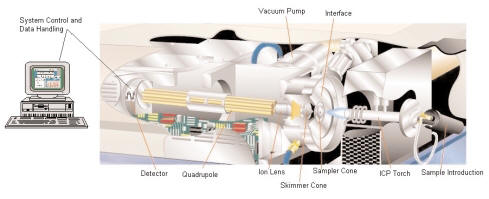 Diagram courtesy of PerkinElmer
Diagram courtesy of PerkinElmer
Laboratory Facilities
PerkinElmer ELAN 9000 ICP-MS 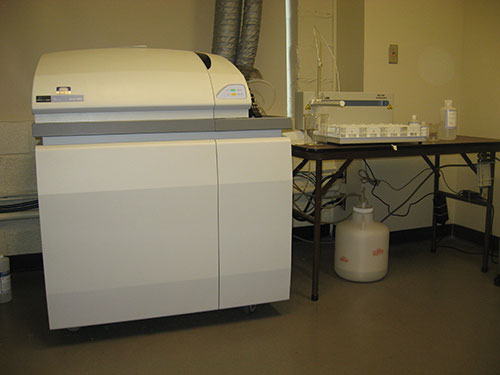 |
Anton Paar Microwave Digestion System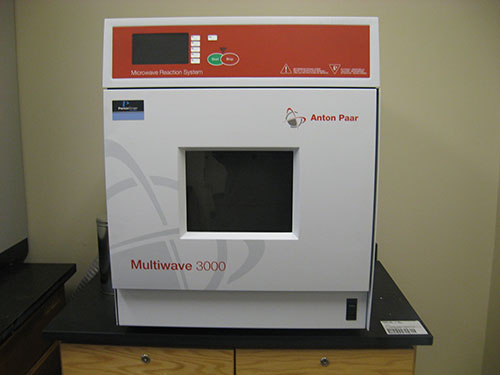 |
Sample Preparation Laboratory 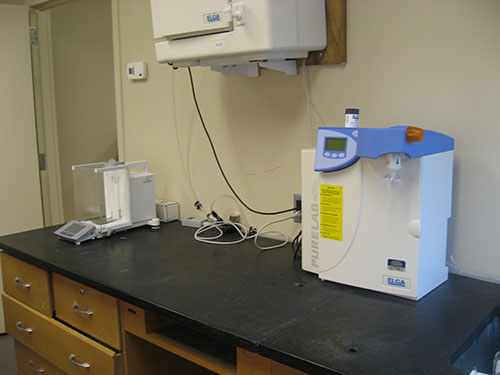 |
Sample Preparation Laboratory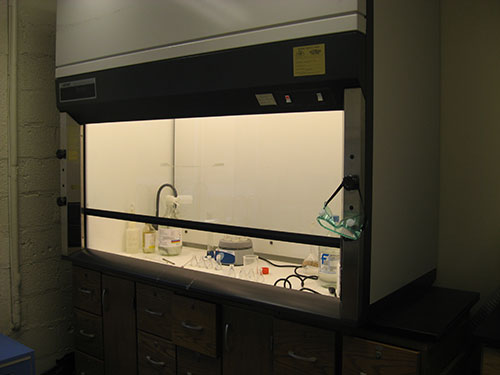 |
Current Student Projects involving ICP-MS
- Development of new ICPMS sample preparation method for digestion of lithium-borate glass in aqua-regia acid
- Investigation of toxic metal concentrations in Tennessee Copper Basin stream sediments
- Mechanisms of formation and chemical evolution of magmas in the central and northern Oregon Cascade Range
- Distributions, Concentrations, and Transport Processes of Toxic Metals Released from TVA Coal-Ash Surface Impoundments into Public Waterways and River Sediments
Faculty Spotlight
Click the image above to see a larger version.
Dr. Mark Abolins teaches a course about earthquakes and folded and fractured rocks (Geol 4080/5080 Structural Geology), a Field Methods in Geology course (Geol 3050), and an on-line course about caves (Geol 3040 Geoscience of Caves). His research foci include (a) the development of caves within folded and fractured rocks, (b) the geology of continental interiors, and (c) the accuracy of geologic maps. In the computer sphere, he uses geographic information system (GIS) software and Midland Valley MOVE structural geology software in teaching and research. He has incorporated state-of-the-art local and global LiDAR (light detection and ranging) elevation datasets into his work.
